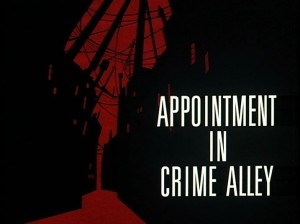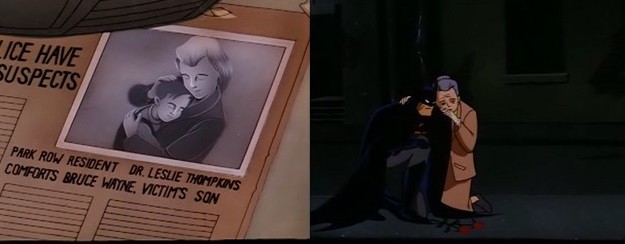 INFO
INFO
Season 1
Production Order: 26
Airdate Order: 12
Original Airdates: September 17, 1992
CREDITS
Written by Gerry Conway
Directed by Boyd Kirkland
 CAST
CAST
Kevin Conroy as Batman/Bruce Wayne
Robert Costanzo as Detective Bullock
Efrem Zimbalist, Jr. as Alfred
Ed Asner as Roland Daggett
Mari Devon as Summer Gleeson
Diana Muldaur as Dr. Leslie Thompkins
Jeffrey Tambor as Crocker
In my previous Batman: The Animated Series review (of “It’s Never Too Late”), I spoke about the aim of the show-runners to make a good series about Batman, regardless of tailoring it to the kid demographic. By the time “Appointment in Crime Alley” aired, the series had already made a huge splash amongst fans and non-fans of all ages. I was only four years old when the show began airing, but since it began its run during prime time television, I vividly recall my Dad talking about how big of a deal it was.
And even as a kid, I remember enjoying episodes of BTAS even if it didn’t feature a “classic” villain, and “Appointment in Crime Alley” is no exception. It’s one of the first episodes of the series to be directly based off of a classic comic story; if you know your Bat-history, you know that story would be “There is No Hope in Crime Alley”! from Detective Comics #457, by comics legends Dennis O’Neil and Dick Giordano. It’s a story responsible for establishing the name and history of the location where Bruce Wayne saw his parents murdered, and is the first appearance of Dr. Leslie Thompkins – who has become a very important member of Batman’s extended family over the years.
I recently had the opportunity to speak with Dennis O’Neil (which you will soon hear in podcast form), and when I asked him which of his Batman stories stand out to him the most, “There is No Hope in Crime Alley!” was on his list, primarily for the introduction of Dr. Leslie Thompkins. O’Neil told me about the creation of the character (she was based on a real person), and how he felt that Batman needed some sort of voice or presence from someone outside of his world that could serve as a moral compass of sorts—someone who could get through to Batman and have him question his use of violence – was it always necessary as a means to an end? Or is there another way?
The animated adaptation reintroduces us to seedy businessman Roland Daggett (from “Feat of Clay”), who is now attempting to force Gotham to allow him to redevelop the Park Row area of the city – once a beacon of hope for the city has turned into the slum called “Crime Alley.” Although the city denied his requests, there’s nowhere he won’t go to get what he wants. Bruce Wayne’s story picks up during the middle of this with Alfred informing him of his “appointment” that night that he’s never missed in years. Of course, this time, Batman encounters some problems along the way.
Batman misses his appointment while stopping some of Daggett’s men forcing people from their homes, and Leslie Thompkins – who Batman was heading to visit – starts looking for him when he doesn’t show. She ends up abducted by the men planning to detonate charges around Crime Alley so the city won’t have a choice but to side with Daggett’s plan. Meanwhile, Batman prevents another hostage situation from going south before attempting to track Thompkins down.

It’s at this point in the episode that I really began to realize that despite being a “kid’s show,” the story is effortlessly telling a good story while providing social commentary on corporations, government, and social classes – all under the guise of a Batman tale. Many of Dennis O’Neil’s classic comic stories had that kind of edge to them (look at his Green Lantern/Green Arrow series as well), and it’s fantastic to see this reinterpretation in animated form.
The stakes rise towards the end of the episode as Batman races to save Leslie (and another larger group of residents) before a section of Park Row goes up in flames. Batman is successful, of course, but Daggett is able to pin the blame on his hired goons. By the episode’s end, we discover Leslie Thompkins’ connection to Bruce Wayne’s childhood tragedy.
Overall, this is a superb episode of the now-classic Batman: The Animated Series. The source material was already a fantastic story, and the BTAS spin on it was well done. In my opinion, in addition to the strong story and voice acting, there’s some tricky animation work (featuring the Batmobile stopping an out-of-control trolley) and it has one of the more memorable pieces of original score work in these early episodes. BTAS doesn’t really get too much better than this. – Ryan Hoss













